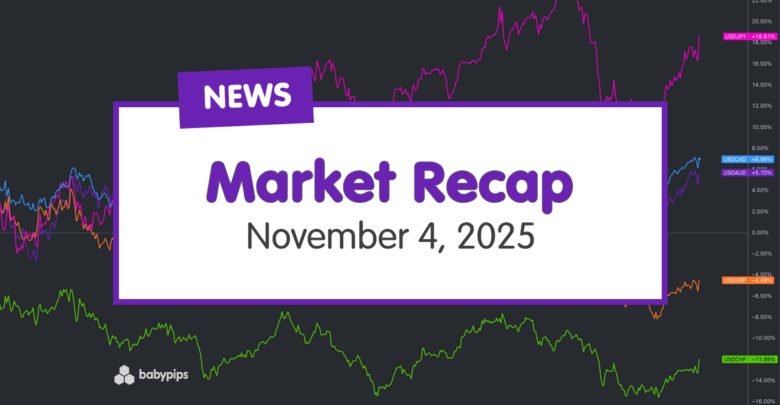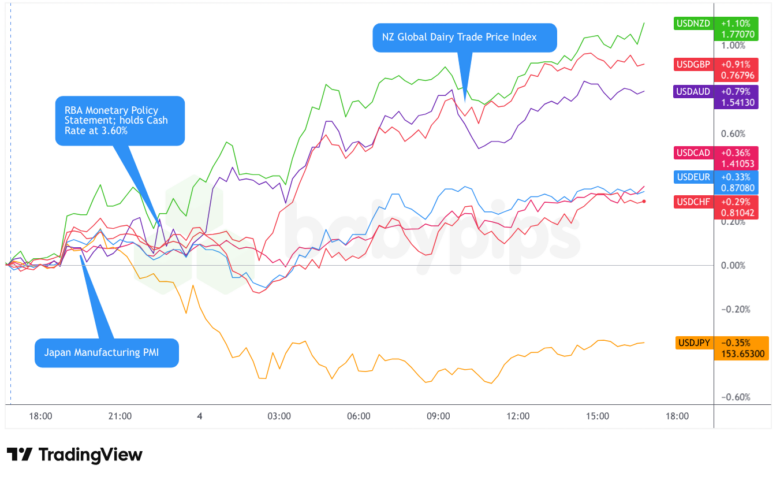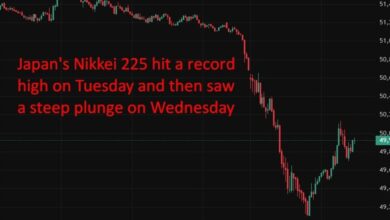Daily Broad Market Recap – November 4, 2025


The broad markets faced mounting pressure on Tuesday as concerns about U.S. equity valuations and diminished expectations for near-term Federal Reserve rate cuts drove a broad risk-off tone, most notably a strong selloff in stocks and cryptocurrencies.
Check out the forex news and economic updates you may have missed in the latest trading session!
Forex News Headlines & Data:
- Japan S&P Global Manufacturing PMI Final for October 2025: 48.2 (48.3 forecast; 48.5 previous)
-
Australia RBA Interest Rate Decision for November 4, 2025: 3.6% (3.6% forecast; 3.6% previous)
- RBA Governor Bullock maintained a neutral stance, stating both further rate cuts and no additional cuts remain possible depending on economic data
- New Zealand Global Dairy Trade Price Index for November 4, 2025: -2.4% (1.0% forecast; 21.9% previous)
- U.S. API Crude Oil Stock Change for October 31, 2025: 6.5M (-4.0M previous)
- The U.S. government shutdown tied for the longest in history
-
New Zealand Employment Change for September 30, 2025: 0.0% q/q (0.1% q/q forecast; -0.1% q/q previous)
- New Zealand Unemployment Rate for September 30, 2025: 5.3% (5.3% forecast; 5.2% previous)
- New Zealand Labour Costs Index for September 30, 2025: 0.5% q/q (0.5% q/q forecast; 0.6% q/q previous); 2.1% y/y (2.0% y/y forecast; 2.2% y/y previous)
Broad Market Price Action:
Dollar Index, Gold, S&P 500, Oil, U.S. 10-yr Yield, Bitcoin Overlay Chart by TradingView
Tuesday’s session reflected growing investor unease as valuation concerns collided with reduced expectations for Federal Reserve accommodation, triggering notable selling pressure across risk assets.
The S&P 500 fell over 1%, with a gauge of technology megacaps losing 2%, as market participants absorbed cautious commentary from major financial institution leaders about stretched valuations, and as concerns grow that the AI trade may be losing steam.
Gold declined approximately 0.8% to trade around $3,930 per ounce, pulling back from recent record highs as the U.S. dollar rose to a three-month high amid reduced expectations for further immediate interest rate cuts. The precious metal possibly faced additional pressure earlier from yesterday’s news out of China, that the government may eliminate tax incentives for gold sales, which could weigh on domestic demand.
WTI crude oil declined 0.8% to settle near $60.10 per barrel, as markets digested signs of falling demand, and an unexpected 6.5 million barrel build in U.S. crude inventories reported by the API, signaling weaker demand or stronger supply dynamics.
Bitcoin experienced substantial losses, dropping 6.8% to approximately $99,640. The cryptocurrency’s sharp decline from $112,000 to below $106,000 triggered over $1.27 billion in leveraged futures liquidations, with long traders accounting for nearly 90% of the total. Federal Reserve officials’ reluctance to endorse another December rate cut, combined with a hack of finance protocol Balancer that drained more than $100 million in digital assets, contributed to the selloff.
The 10-year Treasury yield slid three basis points to 4.09%, as bond markets found support amid the equity market weakness and ongoing concerns about economic conditions under the prolonged government shutdown.
FX Market Behavior: U.S. Dollar vs. Majors:
Overlay of USD vs. Majors Chart by TradingView
The U.S. dollar posted consistent gains throughout Tuesday’s session, rising against all major currencies. With a lack of notable catalysts to point to, there were signs that this bullish move was likely traders continuing to price in recalibrated expectations for Federal Reserve policy, and safe haven flows from equities, crypto and oil markets.
During the Asian session, the greenback built early momentum against major currencies, with traders positioning cautiously ahead of key economic data releases. The Reserve Bank of Australia held its cash rate at 3.6% as expected, but delivered a hawkish tone, noting that inflation has picked up and underlying pressures persist, with core inflation expected to remain above 3% into 2026. Despite the RBA’s hawkish stance, the Australian dollar failed to capitalize, reflecting the broader U.S. dollar strength.
The dollar’s advance accelerated during the London morning session and persisted through the U.S. afternoon, the U.S. Dollar Index rising 0.33% to hover around its highest close since May. Again, no major fresh catalysts to point to, so it’s likely the dollar’s strength once again reflected multiple supportive factors, including reduced expectations for a December Fed rate cut following Chair Powell’s cautious comments last week and the ongoing complications from the U.S. government shutdown depriving markets of official economic data.
Upcoming Potential Catalysts on the Economic Calendar
- Australia S&P Global Services PMI Final for October 2025 at 10:00 pm GMT
- Australia Manufacturing Index for October 2025 at 10:00 pm GMT
- Japan BoJ Monetary Policy Meeting Minutes at 11:50 pm GMT
- China RatingDog Services PMI for October 2025 at 1:45 am GMT
- Germany Factory Orders for September 2025 at 7:00 am GMT
- Euro area Services PMI Final for October 2025 at 9:00 am GMT
- U.K. S&P Global Services PMI Final for October 2025 at 9:30 am GMT
- Euro area PPI for September 2025 at 10:00 am GMT
- U.S. MBA Mortgage Applications & 30-Year Mortgage Rate at 12:00 pm GMT
- U.S. ADP National Employment Report for October 2025 at 1:15 pm GMT
- Canada S&P Global Services PMI for October 2025 at 2:30 pm GMT
- U.S. S&P Global Services PMI Final for October 2025 at 2:45 pm GMT
- U.S. ISM Services PMI for October 2025 at 3:00 pm GMT
- U.S. EIA Crude Oil Stocks Change for October 31, 2025 at 3:30 pm GMT
- U.K. BoE Breeden Speech at 4:15 pm GMT
Wednesday’s calendar features critical U.S. employment data that could significantly influence expectations for Federal Reserve policy. The ADP National Employment Report will provide an early indication of labor market conditions ahead of Friday’s official nonfarm payrolls release, with any signs of weakness potentially reviving rate cut expectations and weighing on the dollar.
The ISM Services PMI will offer insight into the health of the dominant services sector, with particular attention on the employment and business activity components given ongoing concerns about economic momentum under the government shutdown.
The prolonged shutdown continues to compound problems for Americans, including disrupted air traffic due to staffing shortages and reduced food aid benefits, with Transportation Secretary Sean Duffy warning he would close U.S. airspace if travel was determined dangerous. Any fresh developments regarding potential resolution of the shutdown following Tuesday’s elections could trigger significant market volatility.
Bank of Japan monetary policy meeting minutes will be scrutinized for insights into policymakers’ thinking on potential future rate adjustments, particularly given recent yen weakness. Euro area services PMI finals will help assess the resilience of the eurozone economy amid ongoing manufacturing sector challenges. Markets will also monitor any developments regarding U.S.-China trade relations, as progress in trade negotiations has supported both the dollar and yuan, though arrangements are set to be valid for only one year.
Stay frosty out there forex friends and don’t forget to check out our Forex Correlation Calculator when planning to take on risk!




